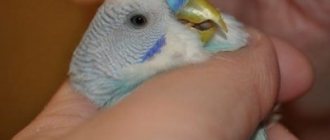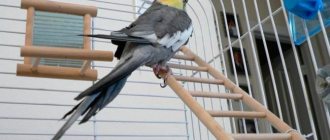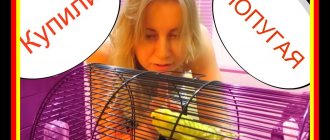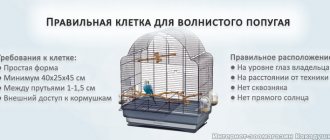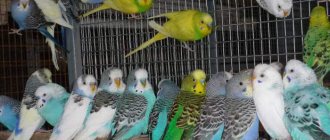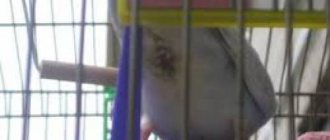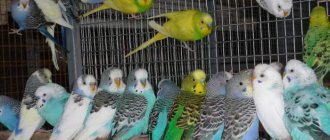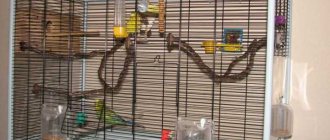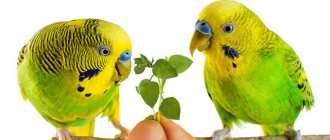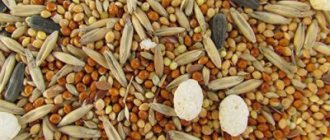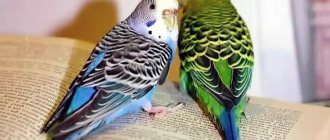Often, bird owners turn to the veterinarian with the question, why is my parrot’s beak peeling? Is this a disease? What caused the delamination? How to fix it? The answers to all questions are contained in our article.
Let's start with how the beak of a healthy parrot (budgerigar, lovebird, cockatiel) should look like. It should be shiny and smooth, evenly colored. If dullness, darkening, peeling, deformation, chips, cracks, or holes are present, this is a signal to take care of the bird’s well-being.
Healthy beak
Reasons why a parrot's beak is peeling
If you notice that your pet (whether it is a budgie, lovebird, African Gray, cockatiel or any other) has uneven edges of its beak, there is no need to worry yet. This is often due to the natural processes of the bird wearing down its nose. She gnaws on a mineral stone, a cuttlefish shell or a fruit twig and in this way shortens her horny areas.
Young budgerigars often have peeling edges on their beaks. These are natural processes of body growth and cell renewal. But damage to the entire surface is an alarming signal.
Change doesn't happen overnight. Initially, roughness appears on a smooth surface along the edges. Then the beak begins to thin out, becomes fragile, and the first detachments appear in the form of hangnails. Afterwards, cracks appear, which can increase when the parrot chews hard food and twigs.
When the beak of budgerigars begins to peel off, the cere also changes: it becomes rough to the touch, and small cracks appear.
Every owner should understand that such chips and cracks are painful for the pet. It is important to know why they appear and how to help the bird get rid of the problem. There are several reasons why a parrot’s beak peels:
- poor nutrition and, as a result, metabolic disorders;
- vitamin deficiency - birds become lethargic, drowsy, apathetic, refuse to eat;
- lack of mineral supplements;
- excessively dry indoor air;
- there are no branches on which the bird can grind its nose;
- illness;
- injuries;
- Sometimes when molting, the beak can also peel off a little.
Causes
Normally, a parrot's beak is smooth, strong and shiny, but it is possible that it may become dull and flake. The cornea is constantly growing, breaking off at the edges, old particles are replaced by young cells. If you do not take into account the natural growth factor, there are certain circumstances in which the formation of keratoid tissue is disrupted.
Then you have to think about why the beak suddenly peels off and how to fix it.
There are several reasons for defects to appear:
- power supply errors;
- conditions of detention;
- injuries;
- diseases.
An unbalanced diet leads to improper metabolism. Lack or excess of vitamins has equally bad effects on the functioning of internal systems. Monotonous grain feed and lack of fresh vegetables in the diet provoke vitamin deficiency. The lack of minerals affects the appearance: the beak flakes and peels, feathers fall off, and wounds appear on the skin.
Attention! Indulging in soft food leads to weakening of the muscles and edges of the jaw bones. Due to lack of work, the horny cover becomes thinner, flakes, and cracks.
Unsatisfactory microclimate parameters are a direct path to the budgerigar’s beak beginning to peel off. When air humidity is low, the shells dry out and cracks appear on them, which increase with feeding. The owner's illiteracy in keeping poultry also plays a role. If a pet is kept in a plastic cage with polymer perches and is not given wooden toys or twigs, it cannot sharpen its beak.
Parrots get injured during conflicts with their cagemates and injure themselves when trying to bite a hard object. After hitting your head against a wall or mirror, blood circulation in the vessels is disrupted and the horny areas peel off.
One of the reasons why a parrot's beak peels and peels is the disease knemidocoptic mange. Scabies mites parasitize the skin and stratum corneum, destroying the structure of the epidermis. Severe itching occurs, which can result in tissue cracking, as the bird is constantly itching.
What to do if a parrot's beak is peeling
The most important thing is to understand the cause of the problem, and then it will become clear what to do when the parrot’s beak begins to peel.
- In case of acute deficiency of minerals and vitamins, in addition to correcting the diet, be sure to add special complexes of vitamins and minerals, give grain sprouts, and offer small quantities of hard-boiled eggs or cottage cheese twice a week. Budgerigars, like everyone else, need to mix crushed eggshells, feed yeast, and chalk with food. Hang sepia and mineral stone on the bars of the cage - they will not only enrich the pet with minerals, but gnawing on them will contribute to the natural grinding of the horny areas.
- If the beak grows excessively, or if the bird has injured it and it begins to peel off, the excess stratum corneum is carefully trimmed with special scissors, without touching the blood vessels. An overgrown beak cannot be left without such trimming, as this risks breaking off the beak.
What to do, how to help a feathered friend
Beak problems indicate poor nutrition and vitamin A deficiency.
Did you know? One of the things that makes parrots great pets is their ability to imitate sounds. In the wild, they communicate with other members of the pack using sounds, informing each other about the presence of food or danger. Unlike other breeds of birds, parrots spend their entire lives learning to imitate sound and can imitate the voices of other birds and animals. Smart imitators use alien voices to protect themselves from predators. For example, if a snake approaches the flock, they imitate the call of a hawk, scaring the snake away.
To compensate for this deficiency, oranges and other fruits, herbs and vegetables are included in the parrot’s diet:
- carrots;
- sweet potato;
- zucchini;
- red pepper;
- dandelion leaves;
- mustard leaves;
- beets;
- cabbage;
- spinach;
- melon;
- papaya.
A diet poor in vitamins provokes metabolic disorders.
A peeling beak indicates that the bird’s body is lacking calcium. According to the recommendations of ornithologists, in addition to basic nutrition, winged pets need supplements of minerals and vitamins. Wheat grains sprouted in a humid environment, crushed chicken egg shells, feed yeast and chalk are very useful for parrots.
Did you know? During the breeding season, female parrots lay 2 to 8 white eggs. Most parrots in the wild do not build nests, but instead lay their eggs in hollow trees. After 17–35 days, the babies hatch and are cared for by both parents until they are ready to fly and leave the nest.
When infested with ticks, the floor and walls of the cage, as well as all the attributes in it, are washed with soap, after which they are treated with antiseptic agents (purchased at a veterinary pharmacy).
While washing the parrot's cage, it is temporarily moved out of it into a free cage or cardboard box. If several birds live in a cage, then isolation of the patient is necessary. Treatment of feathered pets against ticks is carried out using insectoacaricidal drugs, such as Aversectin ointment.
Areas of the bird's body affected by mites are lubricated with this preparation twice a week (once every 3-4 days). The owner of a sick bird also needs to do a general cleaning of the entire house.
Important! Toys, perches, houses and other cage equipment made of natural wood must be removed from the cage for a three-month period. This is a necessary condition, since ticks settle in the tree and can cause re-infection.
Prevention
Everyone knows the truth: it is easier to avoid a disease than to treat it later. When a parrot's beak peels off, in most cases, this indicates the owner's inattention to his pet. Try to protect the bird from such an unpleasant condition. Create optimal conditions for her:
- regularly clean and disinfect the cage and all equipment in it;
- replace old branches with new ones, previously scalded with boiling water;
- provide the parrot with constant access to mineral supplements (sand, sepia, mineral stone);
- maintain optimal humidity in the room, do not allow dry air, especially during the heating season, and especially do not install a cage with a bird near heating devices;
- provide a varied diet and conduct vitamin therapy courses twice a year;
- the perches in the cage should be made of wood, it is best if they are strong branches with bark - thanks to such a rough structure, the bird will wear down its beak and claws;
- toys should also be wooden;
- Lighting is very important for birds, in winter - at least 8 hours, in summer - at least 12 hours;
- Examine your pet regularly to notice an impending illness in time and begin to take action.
Why does delamination occur?
When a pet gets sick, its beak becomes thin and fragile. Burrs are observed in some areas. The wax is covered with barely noticeable cracks and appears rough to the touch.
Beak separation can occur for a number of reasons:
- Lack of vitamins and minerals in the bird’s diet.
- Genetic predisposition.
- Bodily injury.
- Knemidocoptosis.
- Unfavorable indoor microclimate.
In some individuals, the beak grows too quickly, acquiring a hypertrophied shape. The bone tissue simply does not have time to form normally, so it begins to delaminate.
Injury
If a pet is injured, damaging its beak in some way, then during the regeneration process the surface is overgrown with a multi-layer protective film. In case of severe fractures, the outermost part dries out, and the remaining part also becomes covered with a white coating.
Knemidocoptosis
The disease gets its name from a type of tick. The activity of insects is manifested in the deformation of the beak, its peeling and delamination.
In addition to the unpleasant visual part, mites cause severe pain to the bird, which is why it constantly itches, sleeps anxiously and is in a state of stress.
If you carefully examine the bird, parasites can be seen at the base of the beak, as well as along the perimeter of the eye sockets. In the course of its activity, the pest creates a branched system of passages, which leads to the destruction of the bone structure, as well as to the appearance of delaminations.
Unbalanced diet
For the development of bones and beak in particular, the budgerigar's body requires a sufficient amount of calcium. If there is too little of it in food or for some reason the gastrointestinal tract does not absorb this element well, then hard tissues begin to peel off.
Lack of other vitamins and minerals can also cause beak splitting, but to a lesser extent. Therefore, nutrition must be balanced. Eating dry food alone is not enough: the diet must be diluted with fruits, vegetables and other products.
It is also useful to read: Fleas on a budgie
Fractures and injuries
With severe bruises, cracks and chips appear on the horny tissue. The plates are split and the jaw bones are displaced. Where blood circulation is impaired, you can see that the beak has darkened. Less commonly, partial tearing of the organ occurs. Parrots, which contain several individuals in one cage, sometimes fight for territory. Violently attacking each other, the rivals inflict serious injuries and damage on each other. One of the most serious consequences of a fight is the tearing of the beak.
If the wound is relatively small, the veterinarian seals the crack with special glue and secures it with wire. Over time, a stratum corneum will grow in place of the broken part. But with a longitudinal fracture, a lot of effort is required to restore the functions of the beak and avoid tissue necrosis. It is difficult to leave a bird with such an injury, because you will have to feed it soft food for a very long time, while protecting it from unnecessary activity.
External signs of bird disease
The main indicator of a bird's health is its plumage. A sign of health is even, shiny, clean, smooth and tight-fitting feathers. If there is the slightest change in these indicators, ruffled hair, dirt or excessive hair loss, you should immediately consult a doctor.
A healthy bird's beak is clean, shiny, without tumors, and has an even color. Any deviations from this, cracks, seals, rapid growth of the beak, discharge from the nostrils indicate a disease.
Signs of the disease may include red, swollen eyes, excessive watery eyes or purulent discharge from them, changes in the color or uniformity of the iris, and itching around them.
The parrot should be treated immediately if the skin on the non-feathered areas, particularly on the feet, peels, becomes lumpy or swollen, changes color and turgor, or develops cracks or growths.
Feather loss, excessive dirtiness, inflammation and swelling of the skin around the cloaca can be a sign of a disease of the internal organs.
Deformations
Although the beak is very hard and firmly attached, it can become deformed. There is a congenital malformation when a chick is born with an irregularly shaped horn. Most often, such birds do not survive because they do not adapt to grab food. The problem may go away over time if the top and bottom parts close together, otherwise the pet will need special care for the rest of its life.
If a parrot's beak becomes bent at an early age, when the keratoid membrane is pliable, things can still change. When the growth zone is affected, irreversible complications arise. With curved, intersecting halves, shape correction is possible. It is important to see the deformation in time and help the pet. Inexperienced owners do not immediately notice that the parrot’s beak has become crooked. The cause may be an adult bird colliding with an obstacle, for example, hitting glass.
Litter is an indicator of parrot disease
The droppings of a healthy parrot have a uniform consistency and a greenish-brown color. A veterinarian's consultation is necessary if the litter:
- changed color or consistency;
- includes bloody, mucous, watery inclusions, undigested food;
- has a strong foul odor.
The owner of a budgerigar should understand that keeping a pet significantly determines its health. Only with proper care, proper diet, regular hygiene procedures and the creation of the necessary psychological environment will the bird live a long and happy life, protected from many dangerous diseases.
Softening
Another trouble that can happen to a parrot is a softening of the beak. This occurs when there is a lack of calcium and B vitamins. In addition, the stratum corneum softens under the influence of fungi or due to infections - viral, bacterial. Tissues become brittle and mobile. The bird protects its beak and cannot peck grain or care for its feathers. This condition is dangerous due to the presence of microcracks into which food gets, decomposes and serves as a source of infection.
Hypovitaminosis is corrected with the help of veterinary drugs: Gamavit, Beaphar (Beafar), Vinka (Vinka). If the defect appears due to an infectious disease, diagnosis and treatment are carried out by a veterinarian.
Attention! Until the beak gets stronger, the parrot needs to be given semi-liquid, crushed foods. Cracks should be treated with medicine, after removing food particles.
Knemidocoptosis
If the beak turns black or grows back, this is not the worst thing that can happen to a parrot. It is much worse if the bird becomes infected with parasites. These microscopic mites of the genus Knemidocoptes infect non-feathered areas of the body: paws, wax, area around the eyes. Pests live in the epidermis and feed on skin flakes. Their movements and waste products cause severe itching. Ticks are not visible during normal examination, but their presence is indicated by the following symptoms:
- the bird itches intensely and pecks its paws;
- growths appear on the wax;
- crusts accumulate around the eyes;
- plaque on the beak.
In the advanced stage of the disease, the mites move to the beak, it peels off, and its structure is destroyed. Due to the abundance of internal channels, it becomes loose and porous. Getting rid of scabies mites is not easy, you need a systematic approach. To begin with, the bird is isolated from other pets. Disinfect the cage and change all equipment. Aversectin ointment or Vaseline oil is applied daily to the skin and keratinized surface. The course of treatment is from two weeks to a month.
Sources of tick infection
Factors that create conditions for scabies mite infection:
- pet stores, where there are not always normal conditions for keeping birds, a proper diet;
- branches brought from the street for perches that have not been properly processed;
- purchased used bird cage or supplies;
- low-quality feed or unbalanced diet;
- deterioration of immunity. A healthy bird can be a carrier of a mite, but not get sick;
- frequent stress.
Features of treatment for parasites
If a parrot has a growth and its beak turns black, this may indicate the presence of parasites. But in addition to growths, other symptoms may be present:
- the parrot scratches the growths;
- the growth can exfoliate and grow;
- the appearance of white and greenish spots on the paws and growth.
All these symptoms can occur when a bird is infected with mites. The mites themselves can only live on the body of parrots; they are not dangerous to humans.
You won’t be able to help yourself at home; it can only harm your pet’s health. Only an experienced doctor can provide examination and treatment, but it is important to start it as early as possible, otherwise the feathered pet may die.
What actions should you take if you have ticks?
The main symptom when a partial mite appears is severe itching of the area with the growth. If you notice that your bird is scratching its beak frequently, it most likely has a mite. Soon a tumor and severe growth of the cornea may appear.
In these cases, you can use the following recommendations:
- First you need to carefully examine your feathered pets. Perhaps, in addition to the growth on the surface of the beak, they developed spots on the surface of the paws, cloaca and eyelids;
- If parasites appear in only one parrot, then it needs to be removed from all of them. This is necessary for prevention;
- a sick feathered pet can be temporarily transplanted into a clean cage or an ordinary box, which after recovery will need to be thrown out and burned;
- All perches, toys, drinking bowls, and mineral stones should be thrown away. The fact is that a tick can live on them for three months;
- Completely clean the cage. First you need to wash it with a weak soap solution. Then treat it with one of the drugs - Neostomozan, Virkon, Virocide, Ecocide S, potassium permanganate. For example, one ampoule of Neostomozan is diluted in 400 ml of water. The resulting solution is enough to wash one cell. After treatment, everything must be rinsed well with hot water, the main thing is that the substance is all washed away, otherwise the pet may be poisoned;
- A thin layer of aversectin ointment is applied to the affected areas. These treatments must be performed every 3 days. In advanced cases, when the beak has turned black, it can be used once every two days. Treatments are carried out until the growth completely disappears.
